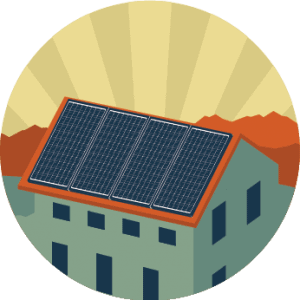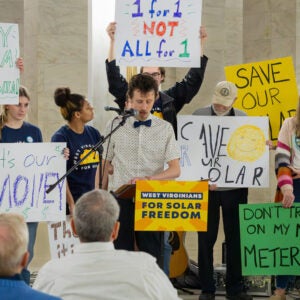 When Congress passed the Inflation Reduction Act (IRA) last August it felt like a personal win for Solar Holler. After nearly a decade of preaching that solar can work in Appalachia, of proving it’ll save families money and strengthen our communities, we finally have a bill that’ll help us achieve our mission of bringing solar within reach of all Appalachians.
When Congress passed the Inflation Reduction Act (IRA) last August it felt like a personal win for Solar Holler. After nearly a decade of preaching that solar can work in Appalachia, of proving it’ll save families money and strengthen our communities, we finally have a bill that’ll help us achieve our mission of bringing solar within reach of all Appalachians.
The (IRA) includes multiple provisions to boost our region’s economy – from job creation to investments in domestic manufacturing and new and extended clean energy tax benefits for families, businesses and nonprofits.
As the Treasury releases more IRA guidance this month, we continue to celebrate what the legislation means for Appalachia. We’re so excited to help folks get all the benefits the bill enables! We also realize that legal jargon can get confusing, so we thought we’d break down some of the key takeaways.
What’s in the IRA?
There is a LOT included in the legislation, but we’re most excited about the investments in clean energy. Here are the main parts of the bill that relate to solar for homes, businesses and nonprofits.
 Homes:
Homes:
The solar tax credit has been increased to 30% and extended for the next decade. That means that 30% of the cost of your solar is returned to you as a tax credit when you file your income taxes.
The legislation also offers up to $14,000 in rebates and tax credits for folks to make their homes more energy efficient. That includes investments to help you upgrade to more energy efficient appliances, add a heat pump or invest in an electric vehicle. With a more energy efficient home, your solar goes even further.
Benefit breakdown for homes:
+ The tax credit increased to 30% of the project cost. That amounts to about $12,000 for our average customer.
+ Up to $14,000 in rebates and tax credits to make your home more energy efficient.
+ Check out this online tool to see what you might be eligible for based on your income and zip code: IRA Calculator
 Businesses:
Businesses:
The benefits are even sweeter for businesses! Businesses are eligible for the same 30% base tax credit – but they’re offered additional tax credits based on some key factors.
The main changes to the solar tax credits for businesses:
+ 30% base tax credit.
+ 10% if you’re located in a former energy community, like a coalfield or brownfield. In Appalachia, many of our communities fall under this classification.
+ 10% if using American made solar panels.
+ 10% – 20% if your business is located in a low-income community.
That’s up to 70% of your project costs returned to you when your business files taxes.
We’re still waiting for the maps to be released indicating what qualifies as an energy community or a low income community. We’ll post them here once we get our hands on them.
 There’s more!
There’s more!
Grant funding significantly increased.
The legislation also strengthened and increased the Department of Agriculture’s Rural Energy for America (REAP) grant program. The REAP program offers competitive grants to help rural businesses go solar. The big news here is that the total grant amount increased from 25% to 40% of your total solar project costs. And – there was a significant increase in the funding pool, making it more likely that you’ll be awarded the grant.
Changes to the REAP Grant:
+ Increased the grant to up to 40% of your total project costs.
+ Huge increase of the amount in the funding pool, upping your chances of getting the grant.
Added together – a best case scenario for a rural business could mean up to 70% in tax credits + 40% in grant funding. In other words, there’s the potential to offset just about all of your project’s costs.
 Nonprofits:
Nonprofits:
In the past, nonprofits were a largely forgotten and ignored area of tax legislation. As non-taxed entities, they were ineligible for tax credits so they slipped through the cracks of well-meaning tax laws. Not anymore. The Inflation Reduction Act addressed that oversight and opened new opportunities to make it possible for nonprofits to go solar with federal support in the form of direct payments.
What’s new for nonprofits:
+ 30% of the project costs are covered with federal benefits.
+ 10% benefit for using American made panels.
+ 10% benefit if your nonprofit resides in an energy community, like a coalfield or brownfield. In Appalachia, we’ve got lots of communities that meet this definition.
+ 10% – 20% benefit if your nonprofit resides in a low income community.
Nonprofits are now eligible to offset up to 70% of the cost of going solar. This makes it possible for nonprofits to save on their energy costs so they can invest even more resources into their missions and advance the good work they do in our communities.
This is the bill we’ve been waiting for to rewire Appalachia.
We’re so gratified to see this legislation come to pass, and we’re really proud of the investments it makes in Appalachian communities. This is the bill we’ve been waiting for to rewire Appalachia. It will help build solar panel and inverter factories in coal communities. It will help us build the supply chain for batteries, wind turbines, heat pumps, and solar panels in America. It supports living wages and apprenticeships for the electricians who bring it all to life. This is the law that will revitalize American manufacturing, bring factories back to Appalachia, and allow us to power our region with 100% clean energy.
When you’re ready to take advantage of these new ways to save on solar, give us a holler. Our staff are pros and will be happy to help you navigate all the doors the IRA has opened for you.


 Homes
Homes Businesses
Businesses There’s more!
There’s more! Nonprofits:
Nonprofits: